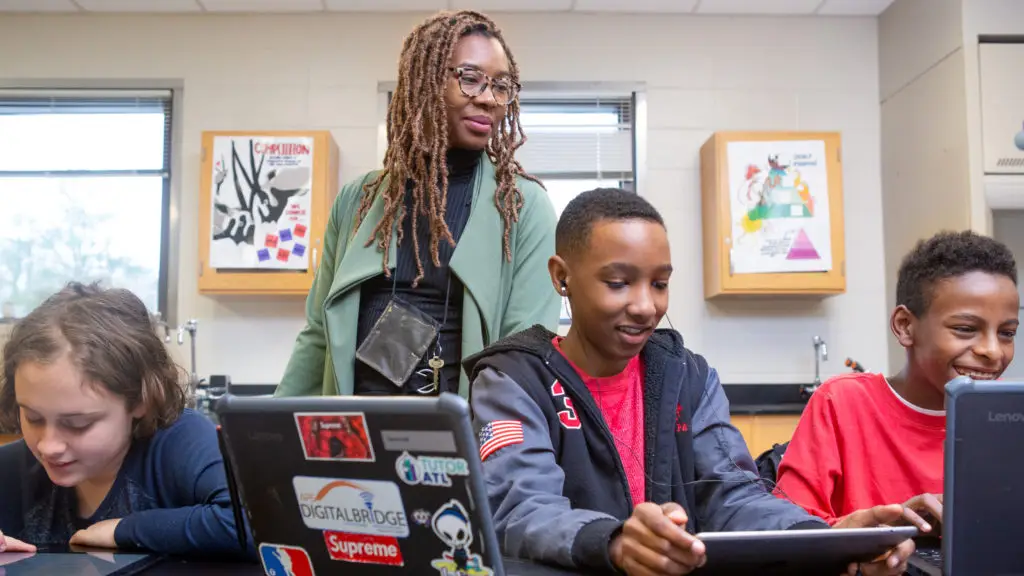The just-passed American Rescue Plan includes $123 billion in new help for schools and hundreds of billions more for state governments. How state and local leaders use this unprecedented infusion of federal funding will be a critical question in the coming weeks and months.
School districts have a once-in-a-generation opportunity to use this money to both help students recover from the immediate effects of the pandemic and to invest in lasting improvements to public education.
Community learning hubs, where students can work in small groups with customized tutoring and mentoring supports, offer one such solution. Many of these programs popped up as a community-led solution to virtual learning, but with additional investment could effectively address student learning loss and lead to durable change.
We’re working directly with six school districts that are partnering with community-based organizations to create and expand learning hubs. While these efforts are in their early stages, they and similar efforts across the country are showing how such community partnerships can be a game-changer for kids.
Last summer, when it became clear local schools would begin the new year remotely, The Mind Trust, an Indianapolis nonprofit, and Indianapolis Public Schools moved quickly to stand up community learning sites across the city and within the district. Churches and neighborhood groups operated small learning centers where students could connect to online classes and receive social-emotional support and academic enrichment.
The Mind Trust is already working with Indianapolis Public Schools to figure out how community learning sites can support students’ post-pandemic recovery. It’s planning a new summer school initiative to help students catch up on academic learning they might have missed during a year of remote learning.
Hundreds of similar efforts sprang up all over the country, backed by churches, museums, and small neighborhood groups. Big-name charities like the Boys & Girls Clubs, the YMCA, and the United Way backed similar efforts on a larger scale. The Center on Reinventing Public Education has identified more than 300 of these community-driven learning hubs.
Before the pandemic, many of these organizations offered afterschool programs or summer camps. The crisis forced them to take on a greater role in supporting student learning and development during the school day. It would be a mistake to push them back to the sidelines of public education. Unlike new tutoring programs that would take months to create through districts, these programs already exist. The tutors are trained and are already working with kids: they are “shovel ready.” Investing in these partnerships would also ensure that tutors and program staff from the communities of color—which have been disproportionately affected by the pandemic—will share in the economic benefits of federal funding.
Such partnerships between school systems and their communities can help school system leaders deal with the issues that are keeping them up at night: Re-engaging students who disconnected from school during the pandemic. Rebuilding trust with families who left the public school system entirely. Tutoring students who fell behind academically.
Many of these groups have strong ties to their neighborhoods. Families who might not feel comfortable returning to traditional schools in-person trusted them to look after their children. These groups can operate on more flexible schedules, providing support that is tailored to students’ and families’ lives.
During the pandemic, communities stepped up in big ways to innovate and help districts meet student needs. They were nimble and responsive and they innovated. Smart districts are realizing they should not let that kind of help disappear.
In Oakland, parent-led pandemic innovations may finally help a school system overcome decades of literacy struggles that have gotten national attention. The Oakland REACH launched online learning hubs last summer to dramatically accelerate student literacy. Now, the parent-run group is working with the school district to improve reading instruction throughout the district. The organization is also training parents on the science of literacy so they can support their children more effectively and make sure the district is applying the science of reading in its classrooms.
Federal relief funding is temporary, but the needs of this generation of students will continue for many years. Investments in community-district learning hubs are a low-cost way to leverage help, flexibility, and new ideas that will meet their needs today and serve as a roadmap to reimagine public education well into the future.





